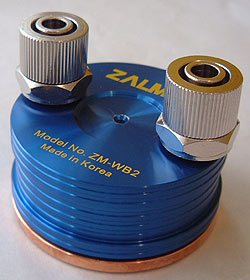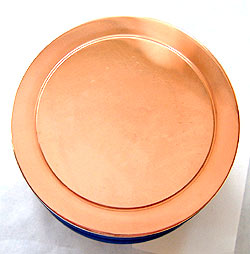Watercooling continues to grow in
popularity, and it should be pretty obvious why.... Water has better thermal conductivity than air,
so it allows you to move more thermal energy from a heat source on a volume-to-volume basis. The key to
watercooling is transferring the thermal energy from the heat source to a heat exchanger (radiator)
which has a larger surface area, and then moving air through that heat exchanger to transfer
it to the surrounding environment.
 |
| Example of a typical CPU waterblock: the Zalman ZMWB2. |
 |
With most computer oriented heat exchangers, a 120mm fan can be used which
is a) quiet, and b) rotates much slower than a conventional heatsink fan does.
Despite the complexities involved, this cooling system, if done properly, will remove more heat, more quietly, and more efficiently than
a standard air cooled heatsink.
There are many
factors when it comes to choosing the right watercooling parts, probably the most
important is the CPU waterblock. All things being equal, a good CPU waterblock can make a big impact in
terms of CPU temperatures, since absorbing the heat and transferring it to the fluid
is one of the most critical factors in a watercooling system.
Next in line of importance is the heat exchanger (radiator). It is
best to choose a unit that is large enough for at least one 120mm fan. I've
tried out smaller ones in the past, and ultimately you'll be doing yourself
a favour by staying away from heat exchangers which use 80mm
fans. Small heat exchangers negate almost all the advantages of
watercooling, due to the small surface area and need for louder fans.
In the watercooling test set up we'll be using for this look at
the relationship between overclocking and cooling, distilled water was used as
the cooling fluild. All tubing was 1/2" inner diameter (ID).
The watercooling circuit itself looks like this; Iwaki MD15-R pump
-> HW Labs BIX heat exchanger with a 120mm 86CFM Delta fan -> DTek
WhiteWater waterblock for the Pentium 4 CPU -> DangerDen Z-Chipset
waterblock -> 1/2" ID Cleaflex60 tubing with Y-splitter to two DTek Procore
heat exchangers with a 120mm 86CFM Delta fan on each -> 4L reservoir.
Experienced water coolers might ask why I chose
to go from the pump to a radiator first, since this will lower the flow rate to
the CPU block. The reason simple, the Iwaki MD15-R pump adds a couple of
degrees (1hr, 8 degrees Celsius) to the temperature of the cooling fluid. I found this
out by trial and error, and the system works best when the water is passed
through the heat exchanger first before moving on from the pump to the CPU
waterblock.
Standard watercooling circuits realistically
only require one heat exchanger, but as I
normally cool a videocard waterblock with a 172W TEC (for added cooling
effect), I decided a couple extra heat
exchangers would help dissipate
the heat better. Again, a standard watercooling circuit only needs one heat exchanger to work.
Now, let's see how this affected our overclocking results!
